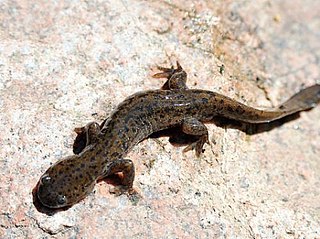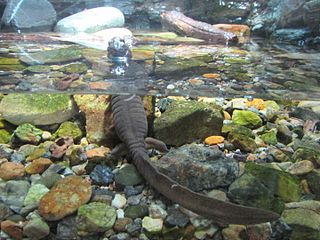
The Asiatic salamanders are primitive salamanders found all over Asia, and in European Russia. They are closely related to the giant salamanders, with which they form the suborder Cryptobranchoidea. About half of hynobiids currently described are endemic to Japan.

The Korean salamander, or Gensan salamander, is the most common species of salamander on the Korean peninsula, and is also found and on Jeju Island and in the north-eastern Chinese provinces of Liaoning, Jilin and Heilongjiang. It typically lives on forested hills, and from time to time mass deaths occur in Korea when salamanders encounter man-made drainage structures. This has prompted Korean government officials to execute a series of mass evacuations in heavily salamandered areas.

Hynobius yangi, the Kori salamander, is a species of salamander endemic to southeastern South Korea. It is a lentic-breeding species similar to the Korean salamander but is distinguished by factors including tail shape and dorsal coloration. The species is known from the vicinity of the type locality in Gijang County in northeastern Busan and from the nearby Ulju County in western Ulsan.

The Abe's salamander is a species of salamander in the family Hynobiidae. It is endemic to Japan and known from southwestern Honshu in northern parts of the Fukui, Kyoto, and Hyōgo Prefectures. The specific name abei honours professor Yoshio Abe, a Japanese zoologist.

Hynobius is a genus of salamander in the family Hynobiidae, occurring in Japan, Korea, China, Taiwan and Far East Russia.

The Odaigahara salamander is a species of salamander in the family Hynobiidae. It is endemic to Japan. Its natural habitats are temperate forests, rivers, and freshwater springs. This species is threatened by habitat loss.

The Oita salamander is a species of salamander in the family Hynobiidae endemic to Japan. Named after Ōita Prefecture, its natural habitats are temperate forests, rivers, intermittent rivers, freshwater marshes, intermittent freshwater marshes, and irrigated land in western Japan. It is threatened by habitat loss, due to the increasing construction of homes within its habitat. The Oita salamander is considered to be vulnerable by the (IUCN) Red List of Threatened Species with a declining population.
The Hakuba salamander or Japanese mountain salamander is a species of salamander in the family Hynobiidae. This salamander is also synonymous with the mountain salamander. It is endemic to Japan. Its natural habitats are temperate forests, rivers, swamps, freshwater springs, and plantations. It is threatened by habitat loss.
Hynobius katoi is a species of salamander in the family Hynobiidae, endemic to Japan. Its natural habitats are temperate forests and rivers.

The Hida salamander or Hondo salamander is a species of salamander in the family Hynobiidae, the Asiatic salamanders. It is endemic to central and western Honshu, Japan. It lives in deciduous, coniferous, and mixed forests, where it breeds in streams. The egg sacs of this species were reported to display blue-to-yellow iridescent glow due to a quasi-periodic diffraction grating structure embedded within the enveloppes of the egg sacs. These salamanders typically spawn from February to April, leading some to metamorphose in late September while others wait for the following year to do so after winter is over.

The Tohoku salamander is a species of salamander in the family Hynobiidae, endemic to Japan. Its natural habitats are temperate forests and rivers.

The Japanese black salamander is a species of salamander in the family Hynobiidae, endemic to Japan.
The Oki salamander is a species of salamander in the family Hynobiidae, endemic to Japan. Its natural habitats are temperate forests, rivers, and plantations. It is threatened by habitat loss.

The Ezo salamander, also known as the Hokkaido salamander, Noboribetsu salamander, or Ezo Sanshouo in Japanese is a species of salamander in the family Hynobiidae. Prior to 1923 the species was also classified by the binomial scientific name Satobius retardatus. H. retardatus is endemic to Japan's northernmost prefecture, the island of Hokkaido. The species is a pond-type salamander, and its natural habitats are temperate forests, temperate shrubland, swamps, freshwater marshes, intermittent freshwater marshes, freshwater springs, irrigated land, canals, and ditches.
The amber salamander, amber-colored salamander, tortoiseshell salamander, or Stejneger's oriental salamander is a species of salamander in the family Hynobiidae, endemic to Japan. Its natural habitats are temperate forests and rivers. It is threatened by habitat loss.
The Hokuriku salamander is a species of salamander in the family Hynobiidae, endemic to Japan. Its natural habitats are temperate forests, rivers, freshwater marshes, freshwater springs, and irrigated land. It is threatened by habitat loss.

The Tokyo salamander is a species of salamander in the family Hynobiidae, endemic to Japan. Its natural habitats are temperate forests, freshwater springs, arable land, irrigated land, and canals and ditches. It is threatened by habitat loss. Many different species of amphibian have unbalanced sex ratios. This trend is no different in Hynobius Tokyoensis; the sex ratio between males and females is about 1.5:1. Although this does not play as large of a role as habitat destruction when it comes to the decline of this species, it is still significant. Considering their environmental preferences, they are usually found in paddy fields. Mid-Summer drainage from these fields hinders the population's ability to thrive as this would occur before these populations could complete metamorphosis.
The Tsushima salamander is a species of salamander in the family Hynobiidae, endemic to Japan. Its natural habitats are temperate forests and rivers.
The Xingan salamander is a species of salamander in the family Hynobiidae, endemic to China: it is only known from its type locality, Mao'ershan in the Xing'an County, Guangxi. Its natural habitats are marshes and the surrounding forests. It is threatened by habitat loss and, living close to the summit of Mao'ershan at around 2,000 m (6,600 ft) asl, by climate change. It occurs within the Mao'ershan National Nature Reserve.












